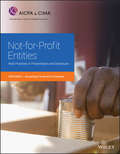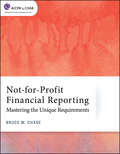- Table View
- List View
Not-for-Profit Entities 2020: Strengthening Audit Integrity Safeguarding Financial Reporting Industry Developments (AICPA Audit Guide)
by AICPAThis Not-for-Profit Industry Development Audit Risk Alert shows changes on the horizon as well as current business environment issues and accounting and auditing challenges such as: Cybersecurity and outsourcing Implementation of FASB's revenue recognition standards Changes to the auditor’s report Preparation for FASB’s leases and other accounting standards updates Delivered in an easily digestible format, this alert also covers legislative and regulatory issues like the unrelated business income tax and changes to IRS Form 990-T as well as a discussion of the Department of Labor’s overtime rule.
Not-for-Profit Entities: Best Practices in Presentation and Disclosure (AICPA)
by AicpaThis valuable resource provides financial statement presentation and disclosure examples illustrating U.S. GAAP compliance for the topics most frequently encountered by preparers of financial statements for not-for-profits (NFPs) by drawing from the audited financial statements of an assortment of NFP entities. Intended for use as a tool to help you create and verify the format and accuracy of your company's or clients' financial statements, this resource walks you through the most common presentations used by other nonprofits for challenges such as noncash gifts, donor-imposed restrictions, and functional expenses. The 2019 edition illustrates the most important, immediate, and challenging disclosures, including: Net asset classes and donor-imposed restrictions Investments, derivatives, endowments, and UPMIFA Liquidity and availability of resources Liabilities, including split-interest agreements and pension plans Contributions and revenue recognition, including grants, contracts, gifts in kind, interests in trusts, and other receivables Analysis of expenses by function and nature Fair value measurements and use of estimates Income taxes and uncertain tax positions for tax-exempt entities Measure of operations and joint costs
Not-for-Profit Financial Reporting: Mastering the Unique Requirements (AICPA)
by Bruce W. ChaseThrough a combination of practical guidance and case studies, the author provides insight into what makes not-for-profits different. Updated for revenue recognition, grants and contracts, and financial reporting, this book offers guidance on FASB's new financial statement standard and revenue recognition standard which will have a major impact on financial reporting for not for profits. It helps answer the questions: Are you aware of how not-for-profit financial statements will change because of FASB's Financial Statement Standard? Do you know what makes not-for-profit accounting and financial reporting different? Key topics include: Grants and contracts Expense reporting NFP financial statement standard Revenue recognition Performance measures
Not-for-Profit Law
by Matthew Harding Matthew Harding Ann O'Connell Miranda Stewart Ann O'ConnellThe law and policy applicable to the not-for-profit sector is of growing importance around the world. In this book, legal experts address fundamental questions about not-for-profit law from a range of theoretical and comparative perspectives. The essays provide scholarly analysis of not-for-profit law, organised around four themes: (1) Politics, in the broader sense of living as a community, and the narrower sense of political power; (2) Charity, how it is defined and changes in its meaning over time; (3) Taxation, including the rationale for government support of the sector through the tax system; (4) Regulation, which is of increasing significance as governments establish increasingly complex forms of regulation of not-for-profit activity. The fundamental aim of the book is to deepen our understanding of not-for-profit law and of the rationales and modes of government support for the not-for-profit sector.
Note for Analyzing Work Groups
by Linda A. HillPresents a model for understanding the behavior and evolution of primary, stable work groups over time. The model describes contextual factors, design factors, and emergent culture as determinants of group behavior and performance. Describes emergent behavior, norms, roles, and rituals as aspects of group life. A rewritten version of an earlier note.
Note on Adjusted Present Value
by Timothy A. LuehrmanDescribes the "adjusted present value" (APV) approach to discounted cash flow analysis. Much of the note is devoted to a critical comparison of APV and an approach based on the wrighted average cost of capital (WACC). Argues that APV is usually, if not always, simpler, more accurate, and/or more informative than using the WACC. Designed to be distributed in conjunction with a case on valuation and captial budgeting. Assumes students are familiar with the WACC but not with APV.
Note on Adjusted Present Value
by Timothy A. LuehrmanDescribes the "adjusted present value" (APV) approach to discounted cash flow analysis. Much of the note is devoted to a critical comparison of APV and an approach based on the wrighted average cost of capital (WACC). Argues that APV is usually, if not always, simpler, more accurate, and/or more informative than using the WACC. Designed to be distributed in conjunction with a case on valuation and captial budgeting. Assumes students are familiar with the WACC but not with APV.
Note on Agriculture in Argentina
by David E. Bell Mary ShelmanThis note describes the history of Argentina agriculture and how it has been affected by government policies and new technologies.
Note on Alternative Methods for Estimating Terminal Value
by William E. FruhanReviews basic techniques for estimating terminal value in the valuation of businesses. Among the techniques discussed are perpetuities, growing perpetuities, use of multiples, and liquidation value. A rewritten version of an earlier note.
Note on Angel Financing
by Paul A. GompersDiscusses the economics of the private equity market and recent efforts by the U.S. Small Business Administration to promote greater angel financing.
Note on Antidilution Provisions: Typology and a Numerical Example
by Walter KuemmerleAntidilution provisions are an important element of most financings offered to entrepreneurs by venture capitalists and business angels. Yet few entrepreneurs are familiar with the different types of antidilution provisions and their mechanics. Compares the three most common scenarios for a financing round: no antidilution protection, weighted-average antidilution protection, and full-ratchet antidilution protection. Discusses the nature of antidilution provisions and provides a numerical example.
Note on Antitrust and Competitive Tactics
by Dennis YaoProvides an overview of antitrust law as it relates to competitive strategy. Discusses the problem of managing antitrust risk and provides a guide to business actions that pose antitrust risk.
Note on Application of the Antitrust Laws to the New Economy: An Analysis of United States vs. Microsoft Corp.
by Constance E. BagleyAnalyzes the 1991 decision of the U.S. Court of Appeals for the District of Columbia Circuit in the seminal New Economy antitrust case United States vs. Microsoft Corp., 253 F.3rd 34 (D.C. Cir. 2001), which arose out of Microsoft's efforts to promote Internet Explorer and to supplant Netscape's Navigator Internet Web browser as the leading browser. This case contains a detailed discussion of the application of the U.S. antitrust laws (Sections 1 and 2 of the Sherman Act, in particular) to technologically dynamic markets characterized by network effects. Issues addressed include: 1) the legality of exclusive dealing arrangements, 2) what constitutes illegal monopolization (including how courts define the relevant market and what constitutes anticompetitive conduct), 3) predatory pricing and the rules of impossibility, 4) the essential facilities doctrine, 5) the exercise of intellectual property rights (such as patents or copyrights) as a business justification, and 6) what constitutes an illegal attempt to monopolize. The U.S. Court of Appeals' decision is summarized, and extensive excerpts from the opinion appear as an exhibit.
Note on Attracting Stakeholders
by Howard H. Stevenson Amar V. BhideAcquiring resources--or to put it more broadly, attracting stakeholders--is a basic entrepreneurial task. While every enterprise needs employees, customers, suppliers, and financiers who are willing to risk their time and money, attracting these "stakeholders" to an entrepreneurial venture is a particularly difficult challenge. This note first describes the importance of the challenge and then the set of tasks the entrepreneur must work on in order to overcome it: Designing the enterprise to minimize the stakeholder investment needed, selecting the right stakeholders, and then convincing them to participate in the enterprise.
Note on Bank Loans
by Susan L. Roth Scott P. MasonDescribes traditional bank lending product, the role of the lending officer, credit evaluation, and the structuring of credit facilities and loan agreements.
Note on Bankruptcy in the United States
by Timothy A. Luehrman William A. TeichnerAn introduction to, and summary of the laws, rules, and procedures established in the United States for settling the claims of creditors on a bankrupt company. Covers both Chapter 7 liquidations and Chapter 11 reorganizations.
Note on Basic Option Properties
by George Chacko Peter Hecht Vincent Dessain Anders SjomanOptions are contracts that give the right, but not the obligation, to either buy or sell a specific underlying security for a specified price on or before a specific date. Explains the basis of options, covering fundamentals such as option terminology, the payoff schemes of options, parameters that influence their value, the put-call parity, and the upper and lower bounds of options prices. Presents problems for students to solve.
Note on Behavioral Pricing
by John T. GourvilleThe note introduces the behavioral or psychological aspects of consumer price acceptance. Begins by reviewing the traditional economic approach to product pricing and consumer price acceptance--namely, that consumers should be willing to purchase anytime a product's perceived value exceeds price. This purely economic approach questioned, and the concept of transaction "fairness" is introduced as an additional component of consumer price acceptance. Through paired vignettes, the behavioral side to product pricing is explored in some detail. In the end, the traditional economic perspective on product pricing is combined with the behavioral or psychological perspective to provide a more realistic understanding of how consumers respond to a firm's pricing decisions.
Note on Blockchain and Bitcoin, 2017
by David B. Yoffie Anthony K. WooIndustry and Background Note: Blockchain was a self-sustaining, peer-to-peer ledger technology with an integrated set of computer codes for managing and recording transactions without the involvement of any central authority.1 The technology represented an innovation in information storage and distribution that eliminated the need for a trusted party to facilitate digital relationships.2 Although originally devised for the digital currency bitcoin, blockchain technology promised to make data storage and management processes more democratic, secure, transparent, and efficient.3
Note on Bond Valuation and Returns
by George Chacko Peter Hecht Vincent Dessain Monika StachowiakAll securities can be evaluated based on certain common characteristics: value, rate of return, risk, maturity, and so forth. This case examines how bonds are valued and how their rates of return are computed. It begins with basic definitions and features of fixed-income instruments and proceeds to basic bond mathematics. An overview of the U.S. Treasury market is provided, as well as some national markets for other important domestic government bonds.
Note on Building and Leading Your Senior Team
by Linda A. Hill Maria T. FarkasAs performance demands intensify in fast-moving global markets, more executives are coming to rely on senior teams for strategic and operational assistance. Team building with powerful senior executives presents special challenges, including competition for their boss' position. Examines those challenges and describes in detail two primary responsibilities of managing such teams effectively: managing team boundaries, that is, the political dynamics of the team; and team process-leading the team. Contains a special appendix discussing leading and building global teams. To discuss how to build an effective team culture by harnessing the energies of talented, diverse individuals to create coordinated action.
Note on Building the Self-Sustaining Firm
by Amar V. BhideDescribes the strategic and organizational challenges of turning a fledgling enterprise into a self-sustaining business. In contrast to traditional life-cycle models, the note argues that businesses evolve in idiosyncratic ways. Therefore the leaders of young businesses have to develop strategies while taking into account the whole situation (rather than a "stage of growth") and after consideration of a broad mix of options. Furthermore, success in attaining sustainability is as much a matter of execution as it is of picking the right growth strategy.
Note on Bundled Payment in Health Care
by Regina E. Herzlinger Charles C. HuangThe note explains how bundled health care payment differs from fee-for-service payment; provides examples of the difference between the two; describes early innovators in bundling and their results; provides guidance on how to make it happen; and elucidates the legal issues bundling raises. Bundled payment will replace virtually all other health care payment formats. This note explains how and why.
Note on Business Model Analysis for the Entrepreneur
by Richard G. Hamermesh Taz Pirmohamed Paul W. MarshallDescribes the primary elements and defining characteristics of a company's business model from the perspective of an entrepreneur. Introduces several analytic techniques and provides illustrative examples of business models to support the analytic framework presented.
Note on Capital Cash Flow Valuation
by Richard S. RubackPresents the capital cash flow method for valuing risky cash flows. In this method cash flows are calculated to include the benefits of interest tax shields. In a capital structure, with just ordinary debt and common equity, capital cash flows equal the flows available to equity--net income plus depreciation less capital expenditure and the change in working capital--plus the cash interest paid to bondholders. The interest tax shields decrease taxable income and thereby increase cash flows. Since the interest tax shields are included in the cash flows, a before-tax interest rate that corresponds to the riskiness of the assets is appropriate to value the capital cash flows.



